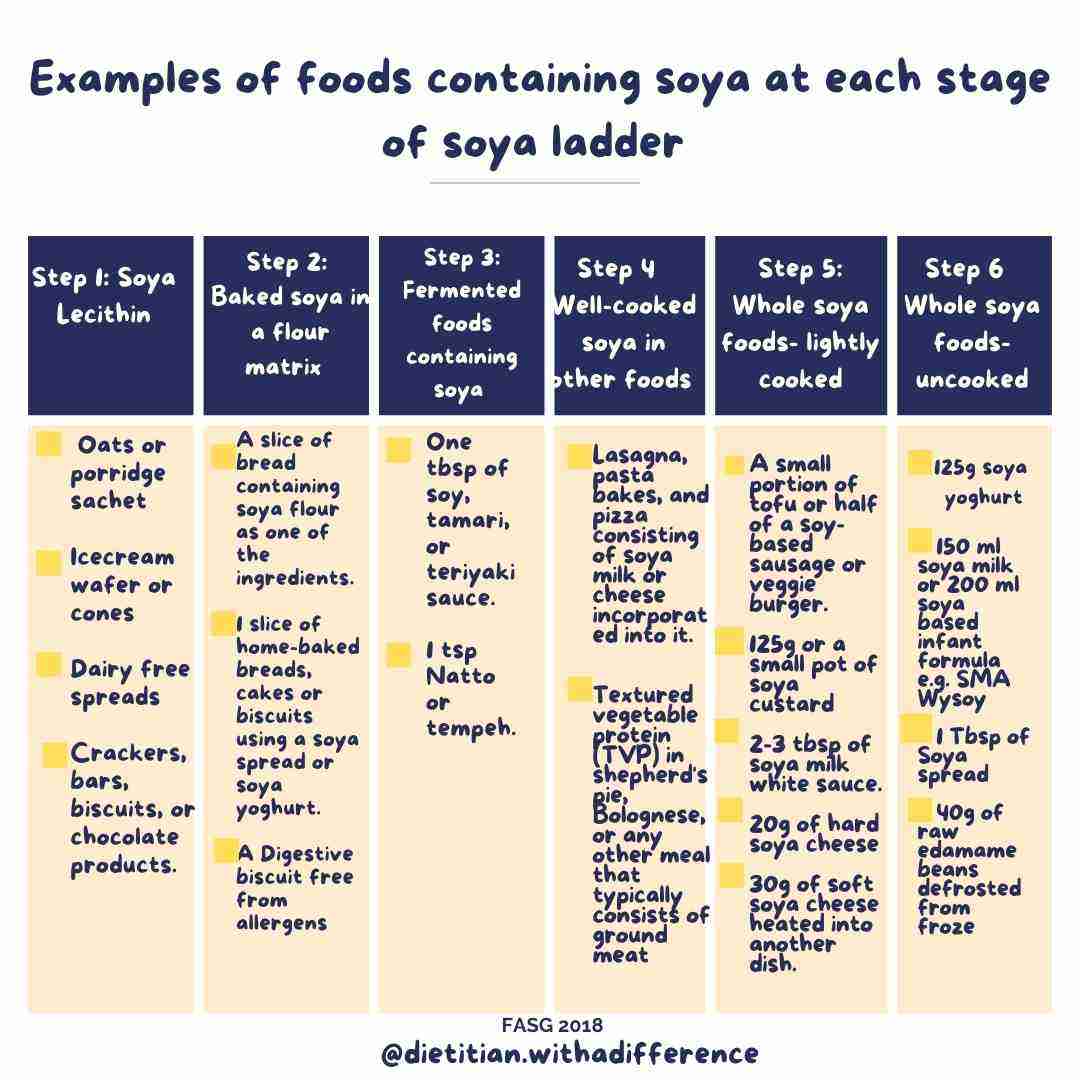What is the Soya Ladder?
The Soya Ladder is a method of safely and slowly reintroducing soya to a child who had a previous allergic reaction, specifically a delayed or non-IgE mediated reaction.
The ladder begins with more processed soya foods containing only traces of soya lecithin and progresses to fermented foods, then to cooked or baked food, then to lightly cooked foods, and ends with an uncooked soya product.
This process is followed considering products that have been process, cooked/baked or even fermented are not as likely to result in an allergy flare up in comparison to less-cooked or uncooked foods. Your child will go from each step of the ladder based on how they tolerate the soya products at the previous step.1
Ladders are common for many different allergies and follow a similar approach. Due to the absence of guidelines for navigating non-IgE mediated allergies, the ladder approach was developed as a home introduction protocol (HIP) for common allergens such as milk, soya, eggs, and wheat.
While there are other methods of testing for food allergies such as a skin prick test, oral food challenges (OFCs) are currently the most reputable methods of confirming an allergy.2
What is a soya allergy?
When you hear, “soya allergy”, you may think of whole foods like tofu, edamame, soy sauce, soy milk, or plain soya beans. What many people don’t realise is it’s also commonly found in trace amounts in 60% of pantry goods on the market today, making it tough to avoid for those with soya allergies!3
If your baby has had a delayed reaction to soya in the past, keep reading! This article may help serve as a guide for parents who have a child who have or are growing out of a non-IgE-mediated allergy to soya.
Difference IgE and non-IgE-mediated Allergy
Allergic reactions may occur in three different forms: IgE-mediated food allergy, non-IgE-mediated food allergy or a mix of both!
Immediate-type or IgE-mediated food allergies are caused by the production of the antibody, immunoglobulin E (IgE) in the body’s immune system.
Delayed-type or non-IgE mediated food allergies are not caused by immunoglobulin E, instead they are caused by other cells within the immune system.
Mixed Ige and non-IgE-mediated food allergies are a combination of the IgE-mediated and non-IgE-mediated allergy types. They occur when someone experiences symptoms from both allergy types.4
Signs and symptoms
The symptoms of an IgE-mediated food allergy often occur within seconds or minutes of eating a specific food. Whereas, the symptoms of a non-IgE-mediated allergy often take a lot longer to appear- taking between 2 hours and up to several days in some situations.
Symptoms of an IgE mediated allergy
These symptoms of an IgE-mediated allergy may include itching in the mouth, itchy red skin or hives, swelling of the throat, face, or mouth, difficulty swallowing, wheezing or shortness of breath, dizziness or lightheadedness, nausea or vomiting, abdominal pain or diarrhea, hay fever symptoms.5 IgE-mediated allergies also are associated with a greater risk of anaphylaxis- a life threatening allergic reaction!6
The symptoms of a non-Ige-mediated allergy
The symptoms of a non-Ige-mediated allergy commonly occur on the skin, resulting in red, itchy, dry and/or cracked skin. Other symptoms are in the form of gastrointestinal issues such as abdominal cramps, constipation, vomiting, diarrhea, or colic (in babies).5
It can be challenging to decipher whether these symptoms are a result of a food allergy or another existing factor such as anxiety, stress, and/or illness. Therefore, it is important to rule out the possibility of an allergen.
Before you start the ladder
Prior to beginning the soya ladder, it is best to ensure there are no current health conditions or other external factors that may interfere with the reintroduction phase.
If your child is experiencing a cold, flu, hay fever, eczema, asthma, diarrhea, or vomiting, then hold off on reintroduction until those symptoms subside. This will prevent those symptoms from being falsely interpreted as an allergic reaction.
Don’t start if your child is on a newly prescribed medication, then wait at least two weeks of taking the medication before the introduction of soya to the diet.
It is important to only introduce one new food or allergen at a time during the phase of reintroduction to avoid misinterpreting the symptoms from one food as a reaction to soya.
How to start the soya ladder
- It is also recommended to spend at least three days at each stage of the soya ladder. If an allergic reaction occurs, do not move onto the next step. Stop giving food if unsure if child is having a delayed reaction and speak with your doctor or dietitian about whether to continue (4)
- Plan it out! Start reintroduction during a time you are able to more easily observe your child, such as on a weekend or a holiday. Make sure to observe them for the 2-hour period after eating the soya portion.
- During the reintroduction phase, make sure none of the soya-containing foods contain or have been in contact with one of your child’s other known allergens.
- Keep a food and symptom diary! Record what your child is eating and what symptoms they may experience after consuming the meal.6 7
- If you are unclear as to whether an allergic reaction is occurring, it is best to play on the safe side and stop giving the food. Pay extra close attention to the presence of any symptoms.
Soya Ladder for Home Reintroduction

Step 1: Soya lecithin
Offer a single portion of a food containing soya lecithin each day for 3 days.
Choose one of the following options:
· Oats or porridge sachets
· Ice cream wafers or cones
· Dairy free spreads
· Crackers, bars, biscuits, or chocolate products.
Check the ingredient labels for “soya lecithin”, it is often toward the end of the ingredient list.
If no reaction occurs, it is safe to continue offering a product with soya lecithin freely to your child (7)
Step 2: Baked soya in flour matrix
Offer a single portion of a baked soya in a flour matrix each day for 3 days.
· A slice of bread containing soya flour as one of the ingredients.
If your child has an allergy to cow’s milk, egg, and/or wheat consider the following options instead:
· 1 slice of home-baked breads, cakes or biscuits using a soya spread or soya yoghurt.
· A Digestive biscuit free from allergens
If your child tolerates these options well, you may go ahead and offer a full portion regularly as well as include baked goods containing soya cheese (7).
Step 3: Fermented foods containing soya
Offer a single portion of a fermented food containing soya each day for 3 days.
Fermented soy products include natto, tempeh, and miso paste for soups as well as soy, tamari or teriyaki sauce.
Choose one of the following options:
· One tbsp of soy, tamari, or teriyaki sauce.
· 1 tsp Natto or tempeh.
We know, that is the tiniest amount! The amount given can be increased after stage 6! (7).
Step 4: Well cooked soya in other foods
Offer a single portion of a food containing well-cooked soya each day for 3 days.
Choose one of the following options:
· Lasagna, pasta bakes, and pizza consisting of soya milk or cheese incorporated into it.
· Textured vegetable protein (TVP) in shepherd’s pie, Bolognese, or any other meal that typically consists of ground meat (7).
Step 5: Whole soya foods – lightly cooked
Offer one lightly-cooked whole soya foods each day for 3 days.
Choose one of the following options:
· A small portion of tofu or half of a soy-based sausage or veggie burger.
· 125g or a small pot of soya custard or 2-3 tbsp of soya milk white sauce.
· 20g of hard soya cheese or 30g of soft soya cheese heated into another dish. (7).
Offer one whole uncooked soya foods each day for 3 days.
Step 6 Whole soya foods – uncooked
Choose one of the following options:
· 125 g soya yoghurt
· 150 ml soya milk or 200 ml soya based infant formula e.g. SMA Wysoy
· 1 Tbsp of Soya spread
· 40g of raw edamame beans defrosted from froze
If your child is tolerating whole portions of soya for a week, it is likely okay for them to freely enjoy soya (7)..

Conclusion
Your child likely does not have to live through life avoiding soya at all cost. I hope this article has helped you gain some confidence on how to go about reintroducing soya to your child. Guiding them through a food ladder may be a timely process but don’t despair.
If you like some help with the soya ladder book a free call or book a consultation package to help.
Thank you to Paige Courtier, Student Dietitian for helping with researching and writing the blog



